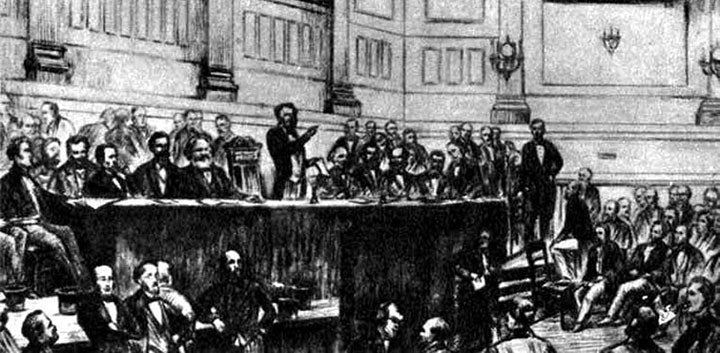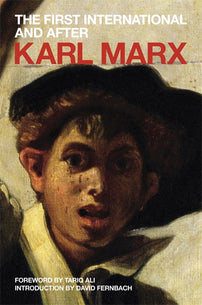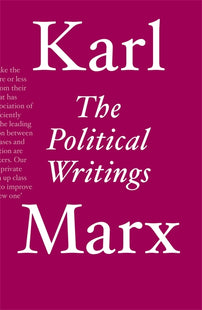Marx and the autonomous women’s movement: A note on the foundation of women’s sections within the First International
On 19 September 1871, when the First International was holding its conference in London, Karl Marx asked to speak and proposed that the delegates adopt ‘Proposal no. 3’, which recommended ‘the foundation of women’s sections among women workers’.

This article was originally published by Revue L’Anticapitaliste 142 in January 2023.
The minutes of the conference of the First International, held from 16 to 23 September 1871 in the house occupied by Karl and Jenny Marx in London,[1] record an instructive debate on the possibility of creating women’s sections within the International. The question was raised on 19 September, at the opening of the meeting, which, as every day, began in the early afternoon and continued late into the night. On behalf of the General Council, i.e. the permanent executive of the International, Marx put to the vote a proposal authorising the creation of purely women’s sections. Although the minutes of the meeting show that Marx’s proposal was adopted unanimously, which actually meant that no one voted against it, they also show that the initiative met with strong resistance, since several delegates criticised it and announced their intention to abstain. Marx’s proposal went beyond simply opening up the International to women’s sections, particularly in raising the question of the ability of the workers’ movement to integrate demands specific to women’s struggles.
Marx based his proposal on two arguments. The first was less contentious, since Marx began by stressing that it was difficult not to have women’s sections in a workers’ international, insofar as ‘industry employs women in great numbers’. The question was all the more obvious, given that, in certain industrial sectors, such as textiles, the manufacturing workforce was essentially female, men being employed mainly in managerial positions.
However, Marx wanted to go much further, as his second argument shows: to take as a model the Paris Commune, which had seen ‘the ardent participation of women’. By invoking the example of the Commune, Marx explained to the delegates that his proposal was aimed at allowing the entry into the International of women’s organisations of the type of the famous Union des femmes pour la défense de Paris et les soins aux blessés [Women’s Union for the Defence of Paris and Care of the Wounded], which had played a fundamental role during the Commune. Marx had followed the creation and development of this organisation very closely, since it had been founded by active members of the International, in particular his friend Elisabeth Dmitrieff, whom he had sent from London to Paris, the day after the insurrection of 18 March, to keep him informed of developments.[2]
[book-strip index="1"]
From Dmitrieff’s letters, Marx had been able to appreciate the energy and potential deployed by the Union des Femmes, which had succeeded in organising a powerful women’s movement, supported by committees in every arrondissement of Paris. Meeting every day, these women’s committees took part in the defence of the Commune while also developing their own social and political demands, particularly in terms of equal pay and the fight against prostitution. The Union des Femmes thus succeeded in making its voice heard by the leaders of the Commune, who had willy-nilly to take into account the growing role of women and their organisations in the management and even the leadership of the revolutionary movement.[3] Supported by this experience, Marx in fact proposed to the London conference that organisations like the Union des Femmes should be admitted to the International, considering that they could strengthen the workers’ movement by bringing it not only the mobilising force of the female proletariat but also their demands.
Unsurprisingly, Marx’s proposal met with reluctance from several delegates, who were not overly enthusiastic about the idea of having to deal with women’s organisations. The Spanish anarchist Anselmo Lorenzo took the floor to say that he was willing to accept the creation of workers’ sections in sectors of female employment, but that he did not agree with the proposal to bring women’s organisations into the International. The Belgian Eugène Steens also regretted that Marx’s proposal was not more restrictive, arguing that there should be single-sex sections only if they corresponded to professional organisations which did not include men. His compatriot César De Paepe took the same line: he feared that this proposal would lead to the creation of ‘a kind of international women’s association’. The debate revolved around one and the same question: should the International be organised on the basis of class struggle alone, or could it be open to the specific demands of women, making their struggle that of the workers’ movement?
It should be noted that the Russian revolutionary Nicolas Outine, who was close to Elisabeth Dmitrieff, approved Marx’s proposal, but stressed that it would be difficult to implement. History proved him right, for although Marx’s proposal was adopted, it was not actually put into practice, due to the ebb of the revolutionary movement, which shattered the feminist upsurge that had accompanied the Commune. Although ‘Proposal no. 3’ had no immediate relevance, it nevertheless retains real historical importance, by showing the extent to which Marx could be sensitive to the revolutionary role played by women’s organisations during the Commune.[4] It is also of theoretical importance in that, although the First International had been founded in 1864 on the idea that ‘the emancipation of the working classes must be conquered by the working classes themselves’, Marx now made a significant correction. ‘Proposal no. 3’ added to the principles of the First International the idea that the emancipation of working women could only be the work of working women themselves. By opening up the International to women’s organisations, Marx was in effect agreeing to combine the struggle of the working class against capitalist exploitation with the struggle that women could wage against their specific oppression.
* * *
Proposal unanimously adopted by the International Workingmen’s Association on the foundation of women’s sections:[5]
19 September 1871 (afternoon session).
Secretaries: J. Hales: English; C. Martin, C. Rochat: French
The meeting opened at 2.30 p.m.
Members present: Coenen, De Paepe, Fluse, Steens, Verrycken, Mottershead, Herman, Vaillant, Outine, Engels, Frankel, Lorenzo, Marx, Bastelica, Perret, Serraillier.
Absent: Eccarius, Cohn, McDonnell, J. Hales, Jung, Dupont
Citizen Serraillier was appointed chairman.
In the absence of the English secretary, Citizen Longuet was asked to take the minutes of the meeting in this language.[6] [...]
[book-strip index="2"]
Proposal 3: Marx read out the following proposal made by the General Council to the Conference: ‘The Conference, on the proposal of the General Council, recommends the foundation of women’s sections among women workers. – It is understood that this in no way prevents the existence of mixed sections.’
Citizen Marx pointed out that his proposal did not exclude mixed sections; he thought it necessary to found purely women’s sections in countries where industry employed large numbers of women. He added a few words recalling the ardent participation of women in the events of the Paris Commune.
Lorenzo asked that women be included in mixed sections when the men making up the section were in the same trade as the women, and in special women’s sections when it was a question of sections for trades that were entirely carried out by women.
Outine supported the proposal, but he saw very great difficulties in its application. On this question, he invited the conference to instruct the General Council to draw up a kind of address to Women Workers in which the false idea of competition between women’s work and men’s work would be clearly exposed.
De Paepe declared that he would abstain. He said that mixed sections had always existed in Belgium, which he approved of entirely, but he feared seeing the association – instead of mixing the female element into a single group – create a sort of international women’s association.
Steens protested against special sections for women who practised trades that were also practised by men; he wanted this type of section to be mixed, he only admitted a women’s section composed of women who practised a trade essentially of their own sex.
The vote was taken. Proposal no. 3 was adopted unanimously.
Translated by David Fernbach
[1] On the London Conference, see Mathieu Léonard, L’émancipation des travailleurs. Une histoire de la Première Internationale (Paris: La Fabrique, 2011), pp. 275-80.
[2] On Elisabeth Dmitrieff, see Yvonne Singer-Lecocq’s recent biography, Rouge Élisabeth (Paris: Stock 2021).
[3] Carolyn J. Eichner, Surmounting the Barricades: Women in the Paris Commune (Indianapolis: Indiana, 2004).
[4] On Marx and the Commune, see Karl Marx and Friedrich Engels, Sur la commune de Paris, ed. Stathis Kouvélakis (Paris: Éditions Sociales, 2021).
[5] From the Marx Engels Gesamtausgabe (MEGA), I /22. Werke, Artikel, Entwürfe, März bis November 1871 (Berlin: Dietz, 1978), pp. 664-6.
[6] The minutes were recorded in French.

